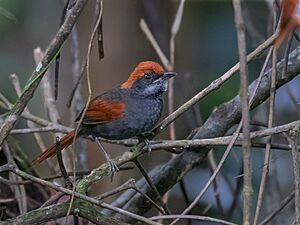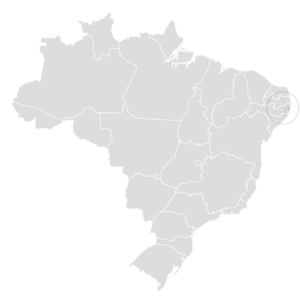Pinto's spinetail facts for kids
Quick facts for kids Pinto's spinetail |
|
|---|---|
 |
|
| Conservation status | |
| Scientific classification | |
| Genus: |
Synallaxis
|
| Species: |
infuscata
|
 |
|
Pinto's spinetail (Synallaxis infuscata) is a small bird that lives only in northeastern Brazil. It's an Endangered bird, meaning there aren't many left in the world. It belongs to the ovenbird family, called Furnariidae. People in Brazil sometimes call it "tatac."
Contents
About Pinto's Spinetail
For a long time, scientists thought Pinto's spinetail was just a type of another bird, the rufous-capped spinetail. But now, they know it's its own special species! It's the only one of its kind, which means it doesn't have any subspecies.
What Does Pinto's Spinetail Look Like?
Pinto's spinetail is about 16 to 18 cm (6 to 7 in) long. It weighs around 16 to 20 g (0.56 to 0.71 oz). Both male and female birds look the same.
Feathers and Colors
Adult birds have a dark grayish face. The top of their head and the back of their neck are a bright reddish-chestnut color. Their back, rump, and the feathers covering their upper tail are brownish-gray. Their wings are mostly a reddish-brown color. Their tail is dark reddish-chestnut and has pointed feathers that get shorter towards the sides.
Underparts and Other Features
Under their chin, they have a small black spot. The rest of their chin and throat have light whitish and gray streaks. The rest of their belly is dark slaty gray, sometimes a bit lighter in the middle. Their eyes are dark brown. Their beak is dark gray, and their legs and feet are grayish or greenish-gray.
Where Does Pinto's Spinetail Live?
Pinto's spinetail is found in certain areas of eastern Brazil. These areas are in the eastern parts of the states of Paraíba, Alagoas, and Pernambuco.
Its Home in the Forest
This bird lives in tropical lowland evergreen forests. It can be found in both old, untouched forests and forests that have grown back. It usually prefers to live in thick, dense plants close to the ground. It can live from areas near the sea up to almost 1,100 m (3,600 ft) high in the mountains.
How Pinto's Spinetail Behaves
Daily Movements
Pinto's spinetail stays in the same area all year round. It does not migrate to other places.
What Pinto's Spinetail Eats
This bird eats arthropods, which are creatures like insects and spiders. It usually looks for food alone or with another bird. It finds its food by picking prey off live and dead leaves, as well as small branches. It typically forages about 1 to 2 m (3 to 7 ft) above the ground.
Reproduction and Life Cycle
Scientists haven't fully figured out when Pinto's spinetail breeds. However, active nests have been found in January and April. Young birds that had just left the nest were also seen in April.
Building a Nest
The nest of Pinto's spinetail is shaped like a ball. It's made from sticks, dry leaves, and pieces of bark. It has a tunnel-like entrance on the side. Inside, the nest is lined with soft leaves or grass and spiderwebs. The birds usually build their nests in branches where they are hidden by climbing plants. These nests are typically 1 to 5 m (3 to 16 ft) above the ground, and rarely higher.
Eggs and Young Birds
A female Pinto's spinetail usually lays two eggs. The eggs hatch after about 21 to 22 days. The young birds leave the nest about 14 to 16 days after they hatch. Both parent birds work together to build the nest, sit on the eggs, and feed their babies.
What Sounds Does Pinto's Spinetail Make?
The song of Pinto's spinetail sounds like "reet, reet" and is usually sung twice. Its call is described as "a spitting trill." It also makes a "chatter" sound that is different from other birds in its group.
Why Pinto's Spinetail is Endangered
The IUCN (International Union for Conservation of Nature) has changed its assessment of Pinto's spinetail over the years. Since 2004, it has been listed as Endangered.
Threats to Its Survival
This bird has a very small and scattered home range. Scientists believe there are only about 250 to 999 adult birds left, and their numbers are still going down. A lot of the Atlantic forest in Alagoas and Pernambuco has been cut down. It's thought that only about 2% of the original forest in this bird's home area is left.
Conservation Efforts
Pinto's spinetail is found in about 60 different places across its range. It is considered uncommon to locally common where it has good habitat. It lives in several protected areas. However, even these areas are at risk from fires that can spread from nearby sugarcane farms. Brazilian authorities also consider this bird to be Endangered.


